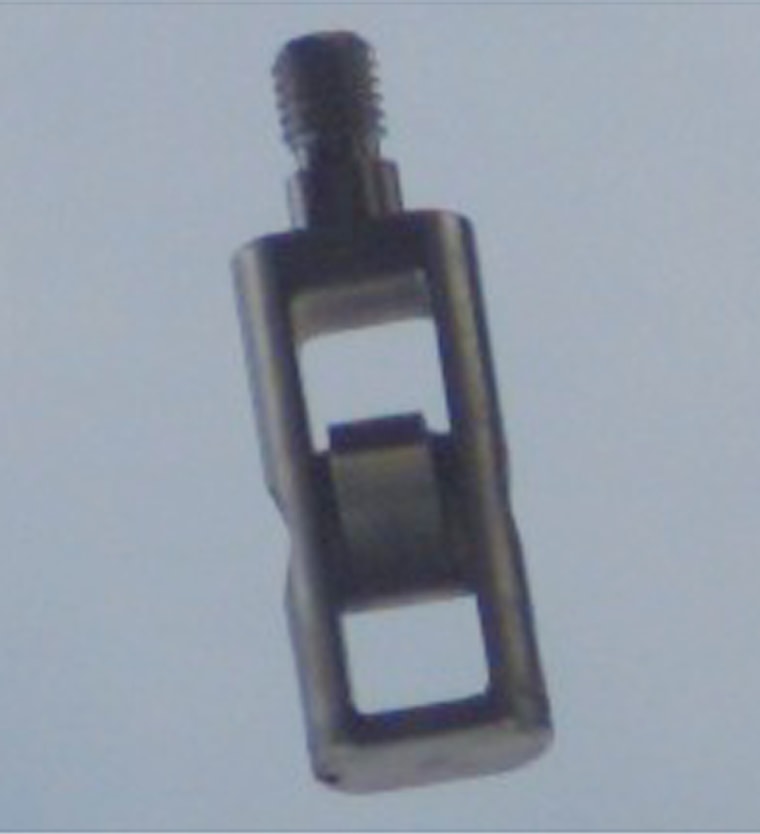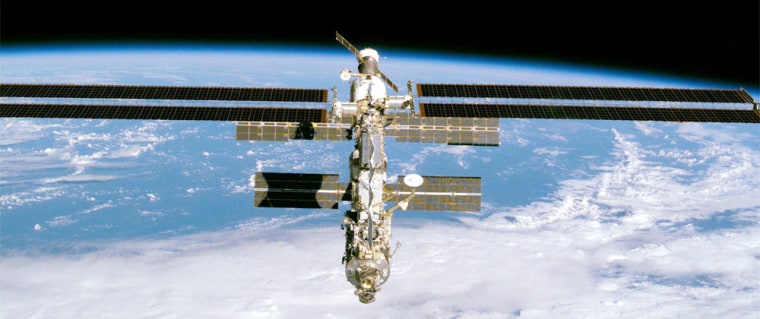The crew of the international space station watched two more pieces of debris floating away from their orbital outpost on Sunday, according to NASA internal reports.
This was the third such sighting in the past eight months. And experts on space debris say that because the crew is looking out only a small fraction of the time, what they see is likely only a small fraction of the material being shed by the station as it orbits 235 miles (375 kilometers) above the planet. Such debris may include fragments of insulation, labels and possibly important components.
In this case, the best guess is that the bits of debris were a bolt and a washer from a Russian-built solar panel, posing no threat of significant damage but sparking an investigation that involved the Russians and the U.S. military as well as NASA.
The latest sighting was mentioned in Monday's daily status report from NASA Headquarters: “Yesterday, the crew observed another small piece of debris floating away from the ISS, apparently of Russian origin.”
According to another NASA document, “The object appeared to the crew to resemble a bolt or a turnbuckle bolt, approximately 2 inches long and ½-inch diameter.”
Spotted from a window
In yet another report on the incident, the crew said they observed the object from the port side window in one of the two sleeping compartments in the station's Russian-built service module. This was the same window from which a larger object had been observed 10 days earlier.
Simultaneously, a television camera on the station's Canadian-built robot arm obtained video images of the object.
The report said the object was metallic, slowly rotating, and was moving forward along the space station at a relative speed of about 2 inches (5 centimeters) per second. It was first spotted drifting slowly beneath the service module’s port solar array panel. The space station's British-American commander, Mike Foale, kept it in sight for several minutes and “reported that the object cleared the front of ISS as it moved away,” according to the report.
Because the station was pointed long-axis crossways to its orbital flight path, this meant that the object “was moving ... [in] an out-of-plane direction,” one report explained. Such a direction opened the possibility of recontact with the station within an hour, but since that would have been in darkness, the object would not be visible. Its low speed and mass would preclude the chance of any significant damage.
Military checks radar
NASA Mission Control in Houston called U.S. military space trackers in Colorado Springs, Colo., who tasked a worldwide net of radars to search for something floating away from the station. After eight passes across tracking sites, the reply was “no joy” — nothing had been seen. The reported size of the object was below what normally would send a readable radar return, and as a rule it is normally very difficult to resolve a small object very close to a much larger one.
Space experts also made a thorough check of the station’s systems to see if there was any sign of something important coming off, or of some activity that might have dislodged an object. The NASA document reported that Mission Control found “no out-of-family [control gyroscope] disturbances at time of report and no recent [thruster] maneuvers.” Further, “an examination of vehicle telemetry showed no significant events around the time the debris was observed.”
“Downlinked photos clearly show a mechanism with a threaded bolt at one end,” the report continued, and some shots “show hand-etched numbers (probably 751 or 757) are visible on several photos.” One image “also shows what appears to be a washer floating several feet from the part.”
Russians provide clues
Images of the object were sent to the Russians, and the boltlike object looked familiar.

“Preliminary info from Moscow indicates that the eyebolt may be from the Soyuz solar arrays,” the NASA report said. “Four of them are used to safe the [solar array] during launch with a hook mechanism, which is released via [explosive bolt] after insertion [into orbit]. The bolts are secured with a nut and a locking wire, and apparently one of them came free.”
The same bolts are used both on the Soyuz crew transport spacecraft and on Progress, the Russian-built cargo-only ship. Both vehicles are currently docked at the station, and NASA sources said Tuesday the Russians now believe the piece actually came off the Progress, which arrived at the space station at the end of last month. In the past, during periods of strong rhythmic thumping on an exercise device, the solar arrays on docked Soyuz and Progress craft can be observed to jiggle.
The crew is preparing to move the station's robot arm tomorrow to position a camera near the solar arrays, MSNBC.com has learned, in order to verify that the suspected piece is indeed missing.
NASA has been sensitized to the issue of debris lost by space vehicles because it was a small piece of debris from the space shuttle Columbia that might have been a timely warning of the fatal damage to the wing’s thermal protection system.
That debris was detected by military radar a day after Columbia's launch, but its significance was not assessed until after the shuttle's disintegration on Feb. 1, 2003. The post-accident analysis showed that the small object was almost certainly a fragment of reinforced carbon-carbon shielding, broken off by impact with insulation from the spaceship’s fuel tank during launch.
Besides providing potential clues to malfunctions of space hardware, departing debris can be hazardous in recontact situations. During a spacewalk in early 2001, a dropped tool drifted away from the station but threatened to circle back due to gravitational effects and hit somewhere on the structure. To avoid damage to delicate surfaces or equipment, the station was nudged out of the path of the tool with the use of rocket thrusters.
During the Apollo missions, debris flaking off spacecraft became such a common occurrence that astronauts and ground controllers nicknamed them "moon pigeons." At that time, NASA created an aggressive safety program to detect and identify all such objects in case any were indicative of some unexpected failure mode of the space vehicles.
James Oberg, space analyst for NBC News, spent 22 years at NASA's Johnson Space Center as a Mission Control operator and an orbital designer.
